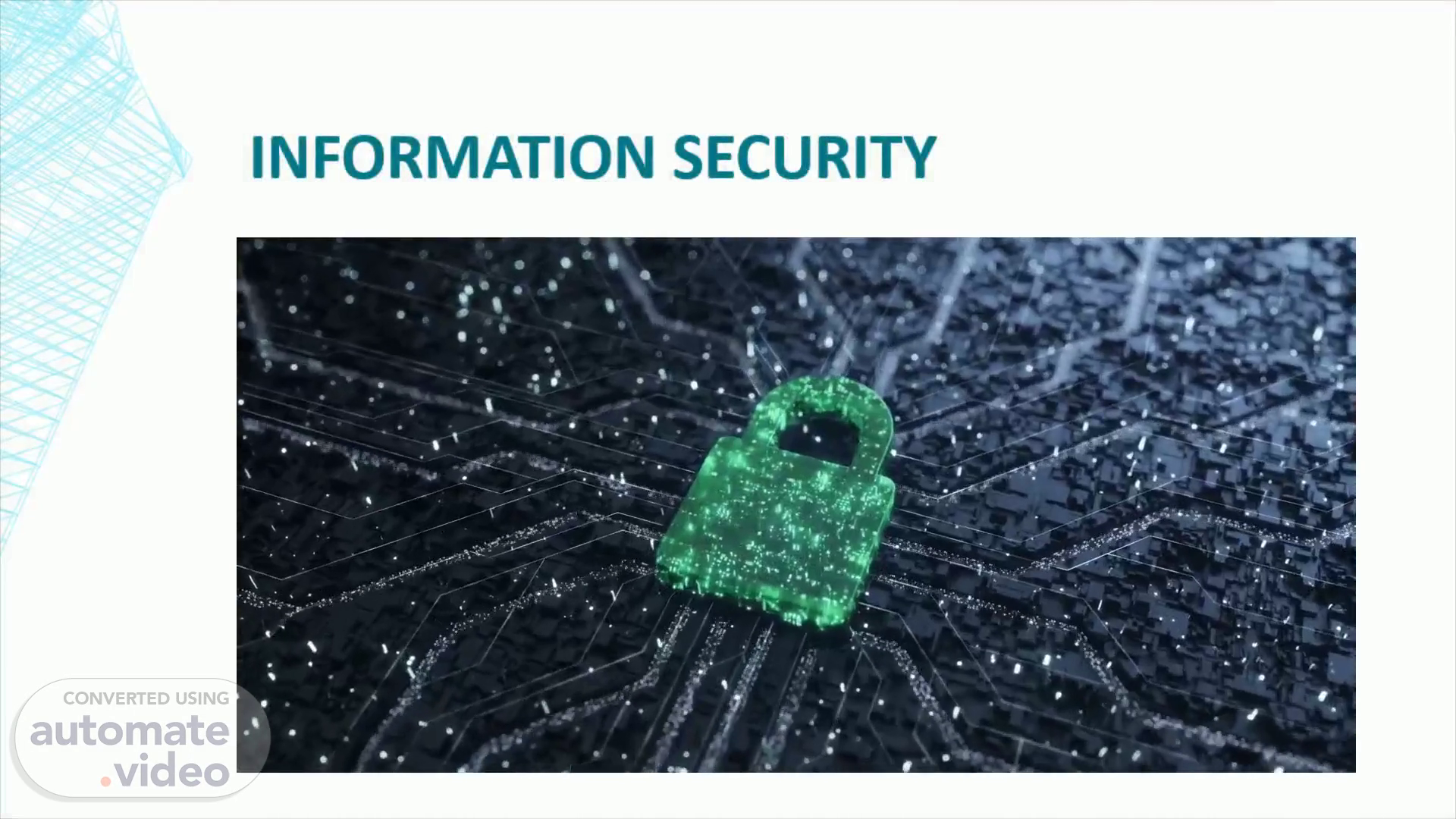
Information Security
Scene 1 (0s)
[Audio] Information Security. Information Security.
Scene 2 (10s)
[Audio] Information security The state of being protected against the unauthorized use of information, especially electronic data, or the measures taken to achieve this. In broader terms, ' information security' means protecting information and information systems from unauthorized access, use, disclosure, disruption, modification, or destruction in order to provide integrity, confidentiality, and availability..
Scene 3 (39s)
[Audio] Cyber attacks are on rise Unfortunately, most cybersecurity breaches are caused by human error. People are often described as the weakest link in any security system. It is important to build security into the entire Human Resource ( HR) process, from pre-employment, during employment, and through termination, to ensure that policies and procedures are in place to address security issues..
Scene 4 (1m 7s)
Quiz. A picture containing text Description automatically generated.
Scene 5 (1m 19s)
Latest cybersecurity Threats. Graphical user interface, application Description automatically generated.
Scene 6 (1m 31s)
Security is everyone’s responsibility. Graphical user interface, text Description automatically generated.
Scene 7 (1m 53s)
Quiz. A picture containing text Description automatically generated.
Scene 8 (2m 6s)
Lock the CIA triad. A picture containing text, wearing, person Description automatically generated.
Scene 9 (2m 21s)
What is CIA Triad. CIA. What is CIA TRIAD. C onfidentiality is a set of rules that limits access to information. Integrity is the assurance that the information is trustworthy and accurate . Availability is a guarantee of reliable access to the information by authorized people..
Scene 10 (2m 37s)
Quiz. A picture containing text Description automatically generated.
Scene 11 (2m 49s)
Information security in the workplace. A group of people working on computers Description automatically generated with low confidence.
Scene 12 (3m 7s)
Contribute towards information Security. A person typing on a keyboard Description automatically generated with medium confidence.
Scene 13 (3m 31s)
Quiz. A picture containing text Description automatically generated.
Scene 14 (3m 43s)
Information security best practices. Graphical user interface, application Description automatically generated.
Scene 15 (4m 2s)
Avoid pop-ups, unknown emails, and links. Beware of phishing. Phishers try to trick you into clicking on a link that may result in a security breach. Hackers also target C-level executives through whaling creating urgency and making them victim of phishing attack.
Scene 16 (4m 19s)
Quiz. A picture containing text Description automatically generated.
Scene 17 (4m 34s)
Use strong password protection and authentication.
Scene 18 (4m 51s)
Connect to secure Wi-Fi. Wi-Fi logo art. Office Wi-Fi networks should be secure, encrypted, and hidden. If you’re working remotely, you can help protect data by using a virtual private network..
Scene 19 (5m 5s)
Enable firewall protection. Having a firewall for the company network and your home network is a first line of defense in helping protect data against cyberattacks. Firewalls prevent unauthorized users from accessing your websites, mail services, and other sources of information that can be accessed from the web. Don’t just rely on your company’s firewall. Install one on your home network if you work from home.
Scene 20 (5m 25s)
Quiz. A picture containing text Description automatically generated.
Scene 21 (5m 36s)
Install security software updates and back up your files.
Scene 22 (5m 59s)
Quiz. A picture containing text Description automatically generated.
Scene 23 (6m 11s)
Talk to your IT department. Your IT department is your friend. Reach out to your organization’s support team about information security. You might have plenty to talk about. It’s a good idea to work with IT if something like a software update hits a snag. Don’t let a simple problem become more complex by attempting to “fix” it. If you’re unsure, IT can help. It’s also smart to report security warnings from your internet security software to IT. They might not be aware of all threats that occur. If a mistake occurs, do not try to hide, for example accidentally clicking on spam link and then hiding it can lead to severe security breaches..
Scene 24 (6m 42s)
Quiz. A picture containing text Description automatically generated.
Scene 25 (6m 55s)
Employ third-party controls. Organizations and their employees may also have to monitor third parties, such as consultants or former employees, who have temporary access to the organization’s computer network. It’s important to restrict third-party access to certain areas and remember to deactivate access when they finish the job..
Scene 26 (7m 12s)
Embrace education and training. Smart organizations take the time to train their employees. Your responsibility includes knowing your company’s cybersecurity policies and what’s expected of you. That includes following them. If you’re unsure about a policy, ask..
Scene 27 (7m 28s)
Quiz. A picture containing text Description automatically generated.
Scene 28 (7m 42s)
You can prevent a data breach. Having the right knowledge — like information security best practices that every employee should know — can help strengthen your organization’s breach vulnerabilities. Remember: just one click on a corrupt link could let in a hacker. Just one failure to fix a flaw quickly could leave your employer vulnerable to a cyberattack. It’s part of your job to engage in safe online behavior and to reach out to your IT department when you encounter anything suspicious or need help. Staying on top of these cybersecurity practices could be the difference between a secure organization and one that a hacker might target..